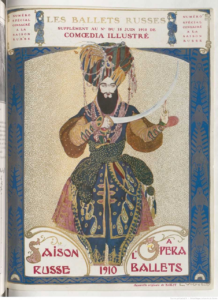Each month, a researcher shares their experiences of using a particular archive. The overall aim of this section is to create a database of the different archives available to those working on French and Francophone studies that will be of help particularly to students just starting out in research.
Sasha Rasmussen is in the second year of her doctorate at the University of Oxford, working at the intersection of gender and sensory histories. She is currently exploring the sensory worlds inhabited by women in Paris and St Petersburg, 1900-1913. Here she talks about the archives available for historians of music at the BNF, in their musée de l’Opéra and Musique-Louvois collections.

This post is intended for historians working on musical topics, historical musicologists, and those who simply want to dip their toes in the rich musical life of the past. Musical sources are often avoided by those without specialist training, creating a significant barrier to interdisciplinary work which simply need not be the case. The bulk of these collections are visual and textual materials relating to music, rather than actual musical scores or sheet music, and the staff are very open and welcoming to non-specialists. I hope this brief introduction to the two libraries will make them more enticing and accessible.
My own research to date in these archives has focused primarily on the Parisian reception of Diaghilev’s Ballets Russes, and so I have worked mostly with specialist arts periodicals and concert programmes. My master’s thesis centred around the dancer Tamara Karsavina – the principal danseuse of the company, who performed as female lead in many of their commissioned ballets – and how her public persona served as a touchstone for wider social debates. At the time of writing, I’m back in Paris for my doctoral research, looking at women’s musical encounters of the early twentieth century.
The two musical wings of the BNF collections – the Bibliothèque-musée de l’Opéra and Musique-Louvois – are situated only about ten minutes’ walk from one another, and both are brimming with great material. Musique-Louvois is just across the square from the BNF Richelieu in a building which is very 1970s brutalist aesthetic; the Opéra library is in a small gilded side-room in the Palais Garnier. I won’t go into detail about the processes of getting a BNF reader’s card, as these are covered quite extensively elsewhere (see http://www.bnf.fr/fr/la_bnf/conditions_acces_tarifs/a.conditions_acces_bib_recherche.html). Expect all the usual security measures at the entrances, mostly a quick squint into your open backpack. Both libraries have lockers for your belongings, and the ones in Musique-Louvois are coin-operated.
By and large, Musique-Louvois operates in much the same way as the other reading rooms of the BNF. You can reserve documents online in advance through the online catalogue, and there are three microfilm readers in one corner. Self-access periodicals are available around the room’s perimeter and on the small mezzanine, which is great if, like me, you prefer reading from paper. Photography is generally permitted, and the staff are friendly and helpful. Upstairs on the mezzanine, I believe there are also one or two small studios with pianos, if you want to play any of the sheet music, although I have never used one of these myself.

Getting into the Opera library is surprisingly straightforward. Go in the billeterie entrance, opposite the Rue Auber, but instead of buying a ticket, bypass the queues of tourists and head through to the small admissions desk under the main staircase. At this point, I tend to defensively brandish my BNF card and say ‘bibliothèque…?’, and the staff nod me through with a bit of a smile (I think they prefer individual readers to large tourist groups). Ascend the extravagant main staircase, go down the left-hand side wing, past the locked case of books and up to the large portrait of a ballerina. On your left, you should see a wooden door marked ‘salle de lecture’ – ring the doorbell and push the door when you hear it click.

Working in the Opéra library is a delight, mostly because of the gorgeous setting. Housed in what was originally the ‘Pavillon de l’Empereur’ and intended for Napoleon III, the reading room feels very lofty, with parquet floors, pastel green columns and a golden chandelier. It’s one of the smaller spaces which fall under the BNF umbrella, with only 16 desk places. The collections here relate primarily to productions staged at the Opera, although it is also a great place to start if you are interested in a particular figure or artistic work. The card catalogue around the walls by reception is worth browsing through as well, as this particular archive has many ‘recueils factices’ which don’t always show up in the online catalogue, but which often contain a few gems. A word of warning – at present, the Opera library does not offer wifi, but has a few clunky computers on which you can access the catalogue if need be.
The fact that both the musical libraries are smaller makes them very friendly places to work and ask questions – because there are never more than a handful of readers, the archivists are generally quite happy to chat with you about your project and what you are hoping to find. Unfortunately, neither has a café, but there are a huge range of places to eat in the surrounding streets – just beware the expensive and flavourless tourist traps immediately surrounding the Opera. Neither library has anywhere pleasant or indoors to sit and eat a packed lunch; if the weather is fine you could try the square outside Musique-Louvois, or head across to the courtyard and foyer of the Richelieu site.
Thank you very much for this, Sasha!



